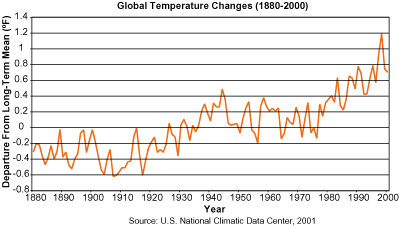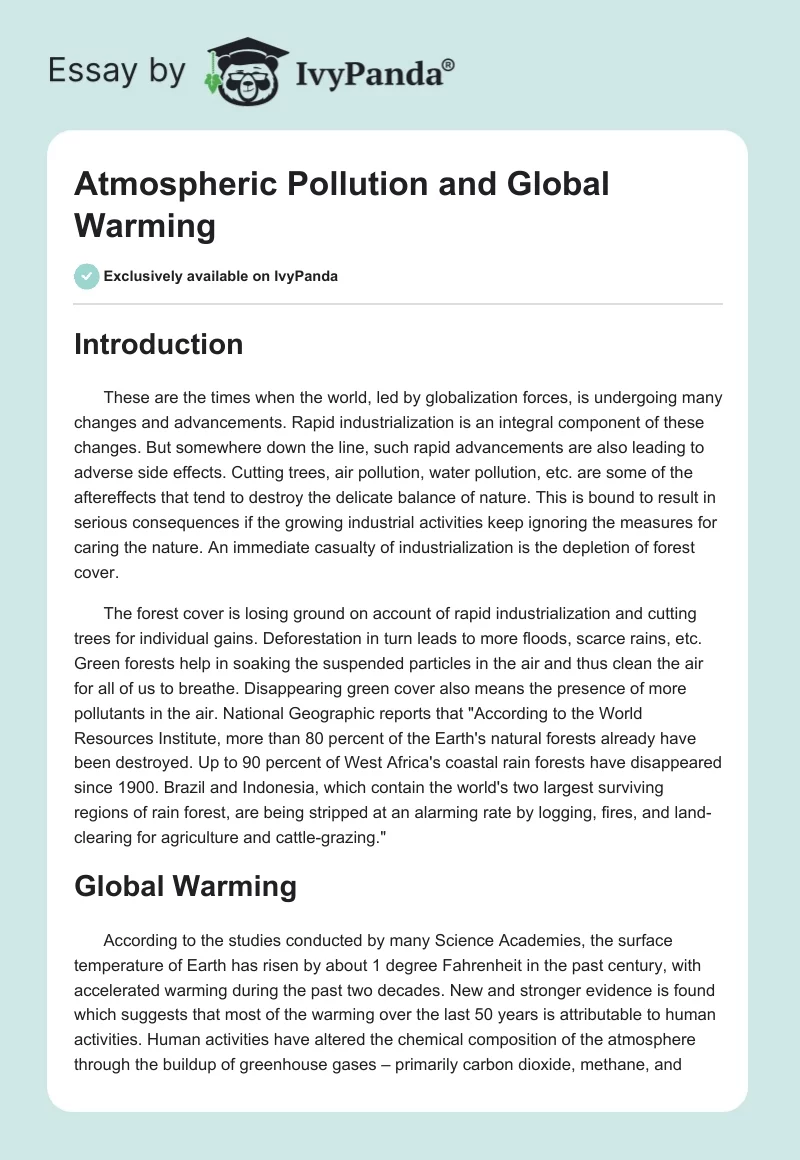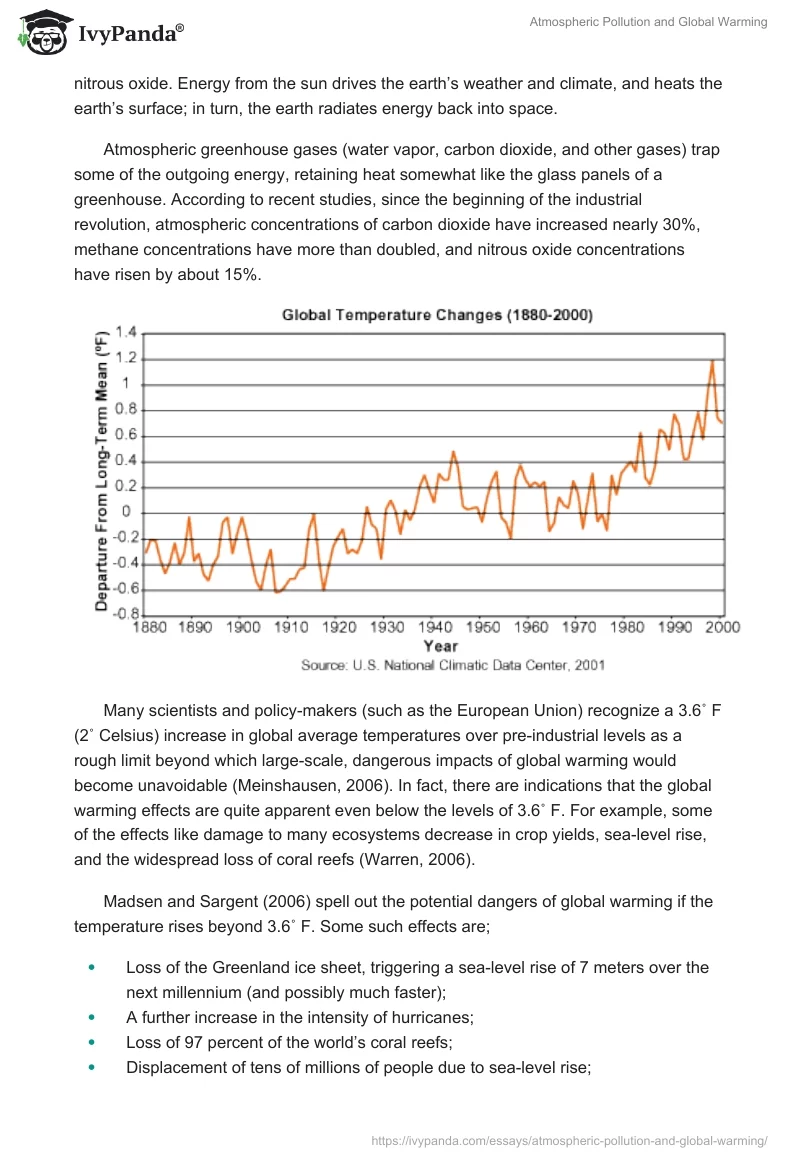Introduction
These are the times when the world, led by globalization forces, is undergoing many changes and advancements. Rapid industrialization is an integral component of these changes. But somewhere down the line, such rapid advancements are also leading to adverse side effects. Cutting trees, air pollution, water pollution, etc. are some of the aftereffects that tend to destroy the delicate balance of nature. This is bound to result in serious consequences if the growing industrial activities keep ignoring the measures for caring the nature. An immediate casualty of industrialization is the depletion of forest cover.
The forest cover is losing ground on account of rapid industrialization and cutting trees for individual gains. Deforestation in turn leads to more floods, scarce rains, etc. Green forests help in soaking the suspended particles in the air and thus clean the air for all of us to breathe. Disappearing green cover also means the presence of more pollutants in the air. National Geographic reports that “According to the World Resources Institute, more than 80 percent of the Earth’s natural forests already have been destroyed. Up to 90 percent of West Africa’s coastal rain forests have disappeared since 1900. Brazil and Indonesia, which contain the world’s two largest surviving regions of rain forest, are being stripped at an alarming rate by logging, fires, and land-clearing for agriculture and cattle-grazing.”
Global Warming
According to the studies conducted by many Science Academies, the surface temperature of Earth has risen by about 1 degree Fahrenheit in the past century, with accelerated warming during the past two decades. New and stronger evidence is found which suggests that most of the warming over the last 50 years is attributable to human activities. Human activities have altered the chemical composition of the atmosphere through the buildup of greenhouse gases – primarily carbon dioxide, methane, and nitrous oxide. Energy from the sun drives the earth’s weather and climate, and heats the earth’s surface; in turn, the earth radiates energy back into space.
Atmospheric greenhouse gases (water vapor, carbon dioxide, and other gases) trap some of the outgoing energy, retaining heat somewhat like the glass panels of a greenhouse. According to recent studies, since the beginning of the industrial revolution, atmospheric concentrations of carbon dioxide have increased nearly 30%, methane concentrations have more than doubled, and nitrous oxide concentrations have risen by about 15%.

Many scientists and policy-makers (such as the European Union) recognize a 3.6˚ F (2˚ Celsius) increase in global average temperatures over pre-industrial levels as a rough limit beyond which large-scale, dangerous impacts of global warming would become unavoidable (Meinshausen, 2006). In fact, there are indications that the global warming effects are quite apparent even below the levels of 3.6˚ F. For example, some of the effects like damage to many ecosystems decrease in crop yields, sea-level rise, and the widespread loss of coral reefs (Warren, 2006).
Madsen and Sargent (2006) spell out the potential dangers of global warming if the temperature rises beyond 3.6˚ F. Some such effects are;
- Loss of the Greenland ice sheet, triggering a sea-level rise of 7 meters over the next millennium (and possibly much faster);
- A further increase in the intensity of hurricanes;
- Loss of 97 percent of the world’s coral reefs;
- Displacement of tens of millions of people due to sea-level rise;
- Total loss of Arctic summer sea ice;
- Expansion of insect-borne disease;
- Greater risk of positive feedback effects like the release of methane stored in permafrost—that could lead to even greater warming in the future.
Symptoms and Factors
If we go around the industrial sites in the outskirts of cities, we can very well experience the change in the environmental equation. The situation is very grave in some of the developing countries, making giant strides towards industrialization. Some aftereffects of brutalities on the environment are reflected in the form of;
- Smog: This term was first used in 1905 by Dr. H A Des Voeux to describe the conditions of fog that had soot or smoke in it. But now smog is being identified with a combination of various gases with water vapor and dust. A large part of the gases that form smog is produced when fuels are burnt. Smog forms when heat and sunlight react with these gases and fine particles in the air. The most harmful components of smog are ground-level ozone and fine airborne particles. The industrial revolution in the 19th century saw the beginning of air pollution in Europe on a large scale and the presence of smog mainly in Britain. A haze of dense harmful smog would often cover the city of London. The first smog-related deaths were recorded in London in 1873 when it killed 500 people. In 1880, the toll was 2000. London had one of its worst experiences with smog in December 1892. It lasted for three days and resulted in about 1000 deaths. London became quite notorious for its smog. By the end of the 19th century, many people visited London to see the fog. Despite gradual improvements in air quality during the 20th century, another major smog occurred in London in December 1952. The Great London Smog lasted for five days and resulted in about 4000 more deaths than usual. In response to the Great London Smog, the government passed its first Clean Air Act in 1956, which aimed to control domestic sources of smoke pollution by introducing smokeless zones. In addition, the introduction of cleaner coals led to a reduction in sulfur dioxide pollution.
- Acid Rain: The phenomenon occurs when sulfur dioxide and nitrogen oxides from the burning of fossil fuels such as petrol, diesel, and coal combine with water vapor in the atmosphere and fall as rain, snow, or fog. These gases can also be emitted from natural sources like volcanoes. Acid rain causes extensive damage to water, forest, soil resources, and even human health. Many lakes and streams have been contaminated and this has led to the disappearance of some species of fish in Europe, the USA, and Canada as also extensive damage to forests and other forms of life. It is said that it can corrode buildings and be hazardous to human health. Because the contaminants are carried long distances, the sources of acid rain are difficult to pinpoint and hence difficult to control. For example, the acid rain that may have damaged some forests in Canada could have originated in the industrial areas of the USA. In fact, this has created disagreements between Canada and the United States and among European countries over the causes of and solutions to the problem of acid rain. The international scope of the problem has led to the signing of international agreements on the limitation of sulfur and nitrogen oxide emissions.
- Fly Ash: With the boom in population and industrial growth, the need for power has increased manifold. Thermal power generation through coal combustion produces minute particles of ash that cause serious environmental problems. Commonly known as fly ash, these ash particles consist of silica, alumina, oxides of iron, calcium, and magnesium, and toxic heavy metals like lead, arsenic, cobalt, and copper. Researches have been attempting to convert this waste into wealth by exploring viable avenues for fly ash management. Fly ash is oxide-rich and can be used as the raw material for different industries. Today, fly ash bricks can be used as a building material.
- Indoor Air Pollution: It refers to the physical, chemical, and biological characteristics of air in the indoor environment within a home, building, or an institution or commercial facility. Indoor air pollution is a concern in the developed countries, where energy efficiency improvements sometimes make houses relatively airtight, reducing ventilation and raising pollutant levels. In urban areas, exposure to indoor air pollution has increased due to a variety of reasons, including the construction of more tightly sealed buildings, reduced ventilation, the use of synthetic materials for building and furnishing, and the use of chemical products, pesticides, and household care products.
Some more impacts of the Eco-Imbalance
Some of the issues that require the immediate attention of the business community in general are;
- Depletion of the ozone layer: There’s a demand from all around for phasing out many products which generate substances that deplete the Ozone Layer. CFCs are particularly destructive to the ozone layer. The chlorine released from these molecules destroys the O3 or Ozone molecules situated in the upper atmosphere. This depletion allows a higher percentage of UV rays and other radiation from the sun to stream into the lower atmosphere, where it adversely affects the health of fellow human beings e.g. the cases of skin cancer have gone up as a consequence. Montreal protocol, in particular, requires periodic assessments of such elements from available scientific, environmental, technical, and economic information.
- Rising levels of Oceans: As a direct consequence of global warming evaporation will increase as the climate warms, resulting in melting in snows in the polar regions and an increase in average global precipitation. This will result in an increase in the sea level. In fact, scientists expect that the average global surface temperature could rise 1-4.5°F (0.6-2.5°C) in the next fifty years, and 2.2-10°F (1.4-5.8°C) in the next century, with significant regional variation. There is new and stronger evidence that most of the warming observed over the last 50 years is attributable to human activities.
- Pollution level in the air: With the reckless industrialization the contamination of air by the discharge of harmful substances has increased to alarming levels. Industries, vehicles, an increase in the population, and urbanization are some of the major factors responsible for air pollution. The source of pollution may be in one country but the impact of pollution may be felt elsewhere. The discovery of pesticides in Antarctica, where they have never been used, suggests the extent to which aerial transport can carry pollutants from one place to another. Major air pollutants are; Carbon Monoxide (CO), Carbon Dioxide (CO2), Chlorofluorocarbons (CFC), Lead, Ozone, Nitrogen oxide, Sulphur dioxide (SO2), Suspended particulate matter (SPM), etc.
Evaluation of current sustainability strategies and solutions
The United Nations Framework Convention on climatic change, popularly known as Kyoto protocol1, in league with another significant agreement paper known as Montreal Protocol, envisages among other things too;
- Promote sustainable forms of agriculture in light of climate change considerations.
- Protect and enhance the sinks and reservoirs of greenhouse gases
- Encourage appropriate reforms in relevant sectors aimed at promoting policies and measures which limit or reduce emissions of greenhouse gases.
- Enhance energy efficiency in relevant sectors of the national economies
This treatise helps in seeing the light at the end of the tunnel, but a nation’s economy depends on many factors, in which, the environment doesn’t figure as a core component till the state of the nation improves to the extent that it feels confident enough to take all its decisions independently. Many of the Third World nations do not enjoy this liberty as yet as they do not have enough resources at their command to take tough measures for safeguarding the interests of the environment. Such nations have to be guided towards better economic conditions and prosperity by their richer counterparts for the environment to become a unified issue.
Economics, the core component of any business, is the study of how people use their limited resources to try to satisfy unlimited wants. Thus mankind has limited resources on the earth, with which s/he must attempt to provide for the worlds’ unlimited wants. Another major force in the environmental marketing area has been firms’ desire to maintain their competitive position. In many cases firms observe competitors promoting their environmental behaviors and attempt to emulate this behavior. In some instances, this competitive pressure has caused an entire industry to modify and thus reduce its detrimental environmental behavior. There are several suggested reasons for firms going environmentally friendly/ using Green Marketing. Some such reasons are:
- Organizations perceive environmental marketing to be an opportunity that can be used to achieve its objectives;
- Organizations believe they have a moral obligation to be more socially responsible;
- Governmental bodies are forcing firms to become more responsible. The US Environmental Protection Agency (EPA) has signed an agreement with the American Chemistry Council (ACC) for promoting the safe management of chemicals in schools (ICIS, 2007). The agreement brings together the ACC’s Responsible Care initiative and the EPA’s Schools Chemical Cleanout Campaign. The move comes after a number of incidents in schools arising out of the mismanagement of chemicals. This move will highlight the need for the safe handling of chemicals. Similarly, the US Occupational Safety & Health Administration (OSHA) has also planned out for an increase in the number of staff trained to carry out process safety inspections. The plan also envisages chalking out a program for inspecting each refinery that falls under its jurisdiction (ICIS, 2007). The move follows a report by the US Chemical Safety & Hazard Investigation Board, which urged OSHA to raise its emphasis on safety at chemical plants.
References
- Meinshausen, Malte, (2006) “What Does a 2˚ C Target Mean for Greenhouse Gas Concentrations? A Brief Analysis Based on Multi-Gas Emission Pathways and Several Climate Sensitivity Uncertainty Estimates,” in Hans Joachim Schellnhuber, ed., Avoiding Dangerous Climate Change, Cambridge University Press.
- Warren, Rachel (2006). “Impacts of Global Climate Change at Different Annual Mean Global Temperature Increases,” in Hans Joachim Schellnhuber, ed., Avoiding Dangerous Climate Change, Cambridge University Press.
- Madsen, Travis and Sargent, Rob (2006). “Making sense of the Coal Rush- The Consequences of Expanding America’s Dependence on Coal”. U.S. PIRG Education Fund National Association of State PIRGs. Boston. Web.
- Kyoto Protocol. Web.
- ICIS (2007). ‘Environment Watch’. ICIS Chemical Business, 17501504, Vol. 2, Issue 60.


